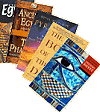|
|
|||||||||||||||||||||||
|
|
Pages in this article: [ UNRAVELLING THE MUMMY ] Identifying the mummies The identification of the mummies found in both caches has been mostly reliant on the authenticity of the dockets found on the bodies. The first attempt to catalogue the royal mummies was undertaken by Gaston Maspero, who published his report "Les mommies royals de Deir el-Bahri" in 1889. Unfortunately, Maspero's study neglected to systematically record and evaluate all the dockets, meaning that his chronology contained blanks and was incomplete. Further academics have tried to compile a definitive chronology using the dockets, namely Elizabeth Thomas's "Royal Necropolis of Thebes" (1966) and Professor Kenneth Kitchen's "The Third Intermediate Period" (1973). In 1990 the English Egyptologist C. N. Reeves decided to address these gaps and blanks by systematically studying all the burials in the Valley of the Kings and Deir el-Bahri. Furthermore, Reeves also methodically examined all extant dockets, which he was later able to classify into three main categories:
The dockets were then sub-divided further into activities according to their hieroglyphic terminology:
On completion of his monumental study, Reeves concluded that the generalised doubt of the identity of the royal caches was irrational and un-warranted. He also wholeheartedly follows the dictate "that the dockets should be accepted as accurate unless there is very good reason to doubt them". He goes on to substantiate this claim by pointing out that some of the mummies found are without dockets, claiming that the ancient restores would not docket a mummy whose identity was questionable. In fact we have only three positive identifications based on inscriptional evidence contemporary with the original burial, those of Tutankhamun, Thuya and Yuya. Reeves's steadfast belief that the identification of the mummies is indeed accurate is not widely accepted by other scholars. Recent investigations have cast doubts on the identification of certain mummies found in the caches. Betsy M. Bryan already had doubts concerning the identities of Ahmose and Seqenera Taa, pointing out that "[they] were found both placed in non-royal coffins of a slightly later date". [iv] She also has concerns regarding Thutmose I and Amenhotep III:
Further speculation to the identity of some of the mummies was raised by Professor E. F. Wente, who in 1995 was asked to make a study of the mummies and noted: "On the mummy, orthography of the king’s name was not without ambiguity, while on the coffin the scribe had originally written the prenomen of Thutmose I and then altered it to Thutmose II … However, the identification of this mummy, lacking any inscription on its bandages, had always been suspect." [vii] Max Miller of the Theban Royal Mummy Project postulates on how the identities of the mummies could have been confused, theorising that it was probably the literate scribes or priests writing out the dockets. The actual removal and reinterment of the mummies would have been carried out by illiterate labourers who, no doubt, would have been given their instructions verbally. If not under constant supervision, "mistakes would inevitably occur". [viii] He goes on adding that due to the size and weight of the coffins, the mummies would have been removed and replaced later when the coffins were sited in their new locations – "a process that would have given another opportunity for confusion to occur." [ix] We are then left with an unenviable situation - if the textual evidence is deemed questionable, is there another method to ascertain the true identity of the royal mummies?
|
||||||||||||||||||||||

|
|||||||||||||||||||||||
|
|||||||||||||||||||||||






